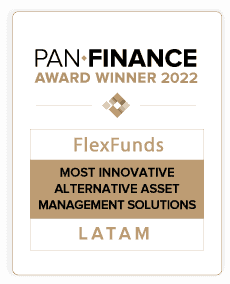- Portfolio diversification will be essential to navigate market volatility. Meanwhile, service personalization will attract new clients and strengthen relationships.
- Product innovation will respond to technological disruption, and adapting to global regulations will be crucial for stability and compliance.
- FlexFunds facilitates portfolio diversification through the design and issuance of investment vehicles (ETPs) with simplified distribution and efficient access to international private banking.
From portfolio diversification to product innovation and adaptability, these are some of the key trends for financial advisors in 2025—a year in which monetary policy is likely to continue influencing investment decisions, and regulatory changes may be at the forefront in key markets like the U.S.
Financial advisors will play a crucial role in navigating a 2025 that is already shaping up to be challenging, amid global shocks caused by uncertainty over interest rate developments, renewed trade and tariff disputes between the world’s major economic powers, and ongoing tensions in the Middle East.
Part of financial advisors’ success will depend on their ability to simplify strategy management, their persistence in finding new opportunities in this evolving landscape, and their capacity to ensure global distribution for investors. Below are some of the key trends for financial advisors in 2025:
Emphasis on portfolio diversification
Diversification stands out as one of the main shields against potential headwinds in 2025. The ability of financial advisors to structure diverse, competitive, and resilient investment portfolios will be critical.
Securitization, a tool that allows traditionally illiquid assets—such as mortgages, various types of loans, and accounts receivable—to be converted into tradable securities for financing, represents an alternative for achieving asset diversification.
According to JP Morgan’s 2025 Investment Outlook1, incorporating alternative assets into investment portfolios provides diversification and inflation protection, even when traditional safe-haven assets are scarce. “Their intrinsic value and tangible nature make them less susceptible to the erosive effects of rising prices, thereby maintaining purchasing power and protecting real returns during inflationary periods,” the report explains.
Incorporating alternative assets into portfolios helps mitigate inflation impact and diversify risks.
FlexFunds positions itself as an alternative for portfolio diversification by creating independent investment vehicles through an asset securitization program. This approach allows the transformation of portfolios into liquid and flexible instruments, making them more accessible to global investors.
Through exchange-listed ETPs, FlexFunds optimizes strategy management and the international distribution of assets, offering a solution that streamlines the structuring process and capital raising for projects using this instrument.
An expanding role for financial advisors
Another major trend anticipated for 2025 is the personalization of wealth management and the expansion of client bases amid a global wealth transfer.
According to investment data and analytics firm MSCI2, “clients now expect customized portfolios that reflect their unique financial goals, risk tolerance and values,” as highlighted in a survey of 220 wealth management professionals.
In this context, client prospecting will also be one of the main challenges for financial advisors. However, on average, they dedicate less than 10% of their time to this critical activity, according to Natixis Investment Managers’ 2024 Global Financial Advisor Survey3.
The report shows that, globally, financial advisors prioritize client acquisition during their peak earning years but are missing opportunities with new generations—except in regions like Latin America. “Given concerns about wealth transfer and asset retention, advisors may want to take a look at how they can better engage this client segment,” the report states.
Regarding client segmentation, Natixis explains that nearly half of advisors (48%) use CRM systems to better manage client relationships and optimize their work. Additionally, 37% leverage artificial intelligence (AI) to automate repetitive tasks and achieve more precise and efficient data analysis.
Advancing product innovation and client experience
Alongside service personalization and portfolio diversification, another expected trend for 2025 is an increasing client demand for innovative products aligned with future trends.
Consulting firm EY anticipates that financial advisors will need to consider the impact of technological disruption on portfolio composition, including, for example, assets suited for tokenization.
“2025 should see firms assess potential growth opportunities from digital assets and tokenization — something that depends on developing the right technology and data infrastructures,” EY states in a report4.
The consulting firm recommends enhancing personalization with new products and collaborating with regulators to foster the adoption of digital assets.
It also advises firms to understand the impact of tokenization on the value chain, identify suitable assets, and stay updated on regulatory developments.
Additionally, the report highlights the importance of developing secure custody services, strengthening data security, and investing in specialized talent in digital transformation and tokenization.
Adapting to complex regulatory environments
Amid the globalization of financial services and constant regulatory changes on the investment landscape, financial advisors must stay vigilant to potential modifications in KYC (Know Your Customer) and AML (Anti-Money Laundering) policies, among others.
“We expect changes to regulation and the overall regulatory and supervisory environment around the world, with the pace and extent varying by country,” anticipated Deloitte5.
The firm explains that financial services companies will face a challenging environment this year, marked by interconnected economic and geopolitical risks, as well as the growing relationship between intermediaries and non-bank entities.
Stricter regulations on cybersecurity and anti-money laundering will shape the financial landscape in 2025.
The Regulatory Outlook Barometer by KPMG6 indicates that among the main regulatory challenges for 2025 are the growing divergence in regulations and regulatory approaches at a global level, which could create operational challenges; the strengthening of frameworks and sectoral policies related to artificial intelligence; and the increased oversight regarding cybersecurity.
It is also expected that controls against money laundering, illicit financing, and fraud in general will be tightened, while states strengthen oversight aimed at consumer protection.
Additionally, crisis management and operational risk management are expected to be prioritized, while greater control over third parties and suppliers is implemented due to the increasing interdependencies and interconnections between companies and industries, according to KPMG.
Balancing growth and profitability
In an environment marked by profit margin pressures and the rise of new competitors, EY experts indicate that one of the priorities for 2025 should be balancing growth with profitability.
They highlight that factors such as global instability, regulatory costs, and evolving product offerings impact operational margins. In fact, “rising costs remain the leading concern of wealth and asset management leaders.”
In 2025, EY suggests that asset and wealth management firms should focus on strategic acquisitions to expand and strengthen key capabilities, particularly in private markets and technologies like AI. Identifying which processes can be outsourced will also be crucial to improving efficiency and profitability.
Additionally, automation, integrated platforms, and external ecosystems will help reduce costs and optimize infrastructure. Lastly, managed services, particularly in finance-related areas, will be key to achieving greater scalability and resilience.
In conclusion, financial advisors are likely to face a challenging 2025, marked by economic uncertainty, technological evolution, and regulatory changes. To stay competitive, they must prioritize portfolio diversification, service personalization, product innovation, and adaptation to an evolving regulatory landscape.
Moreover, cost optimization and balancing growth with profitability will be essential in an increasingly demanding market. In this context, the ability to anticipate trends and respond with agile strategies will define financial advisors’ success in the coming year.
Sources:
1https://am.jpmorgan.com/fi/en/asset-management/adv/insights/market-insights/investment-outlook/portfolio-diversification/
2https://www.msci.com/research-and-insights/2025-wealth-trends
3 https://www.im.natixis.com/en-gb/insights/investor-sentiment/2024/financial-professionals-report
4https://www.ey.com/en_vn/insights/wealth-asset-management/2025-global-wealth-asset-management-outlook
5https://www.deloitte.com/uk/en/Industries/financial-services/analysis/global-regulatory-landscape.html
6https://kpmg.com/us/en/media/news/key-regulatory-challenges-for-2025.html







